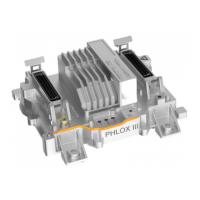8 Switching functions
PHLOX II Ignition Control System 49
The pin state, which activates the switching function, must be configured. There are 2 cas-
es depending if a normal digital input or a tristate switch is used.
- Normal digital input
A normal digital input is configured by setting Par. 4802 / 4806 to 0. The digital
inputs can be configured as high-active, i.e., active when the voltage at the corre-
sponding pin is higher than 7V, or low-active, i.e., active when the voltage at the
corresponding pin is lower than 6V. High-active inputs are designated by positive
digital input numbers in the assignment parameters, low-active ones with negative
digital input numbers.
- Tristate switch
A tristate switch is configured by setting Par. 4802 / 4806 to 1. Tristate switches
have 3 different states (high, low and hi-z) thus a switching function can be acti-
vated at 6 different pin-states (high, low, high-z, not high, not low, not high-z).
The pin-state considered for a particular switching function is configured by set-
ting the corresponding pin-level parameter (Par. 5810 and following):
1 for high
-1 for low
0 for high-z
The assignment parameter itself indicates only which channel is to be used for the switch-
ing function. If, in addition the pin-state has to be negated to activate the switching func-
tion, the channel number shall also be negated.
One single switch may simultaneously activate or be changed over several functions. In
this case, the functions involved will have to be assigned the same input number, possibly
with the activity inverted (negative sign).
If a switching function is required that is permanently active (e.g. when the engine is run-
ning exclusively with Ignition Timing Map 2 which means 2848 SwitchIgnTimMap2Or1
1), any unused (disconnected) digital input may be utilised to activate this function by as-
signing the negative number of the digital input to the switching function.
Switching pulses must have a duration of at least 20 ms in order that the con-
trol electronics recognise them. Any switching function will remain active only
as long as the switch input is active (with the exception of
8.1.1 Ignition
stop).
Parameterising Example:
By closing the switch of input no. 1 you will stop the ignition. For the ignition timing off-
set, you should use a tristate switch on the input no. 2. When the switch is high the ignition
timing offset increases. When the switch is low the ignition timing offset decreases. Hi-z
state does not modify the ignition timing offset.

